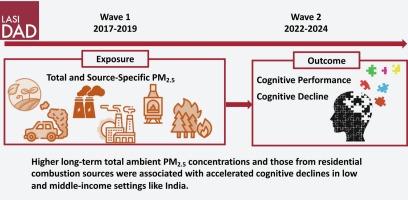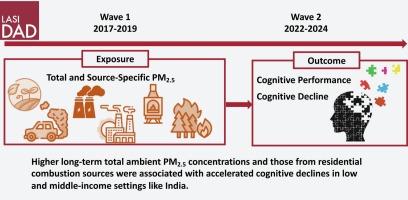Particulate air pollution from different emission sources, cognitive performance, and cognitive declines in India
IF 9.7
1区 环境科学与生态学
Q1 ENVIRONMENTAL SCIENCES
引用次数: 0
Abstract
Background
Low- and middle-income countries experience some of the highest fine particulate matter (PM2.5) exposures globally, with emissions from sources like residential combustion, industry, and transportation continuing to increase in many locations. While total PM2.5 has been linked to cognitive decline, little is known about the relative importance of PM2.5 from different emission sources, especially in low and middle-income settings.
Methods
We used cognitive performance data from the 2017–2019 and 2022–2024 waves of the Harmonized Diagnostic Assessment of Dementia for the Longitudinal Aging Study in India (LASI-DAD) and 5-year average PM2.5 concentrations of total mass and mass from 9 emission sources estimated at each participant’s residential location using spatiotemporal models. We then quantified associations of these exposures with cognitive performance and decline using generalized estimating equation models accounting for survey weights and clustering, as well as adjusted for age, gender, individual and community-level socioeconomic status, urbanicity, place-related covariates, fuel type use, and co-pollutants.
Results
Among 5,699 participants (mean age: 70±8 years), we observed total PM2.5 concentrations ranging from 16 to 206 μg/m3. Higher concentrations of total PM2.5 were not associated with cognitive performance at baseline but were associated with faster declines over time (−0.012/year per SD, 95 % CI: −0.021, −0.004). Among PM2.5 from different sources, PM2.5 from energy production, industry, and residential combustion were associated with steeper cognitive declines over time, whereas PM2.5 from agriculture, transportation, wildfires, and windblown dust were associated with slower cognitive declines.
Conclusion
Higher long-term total ambient PM2.5 concentrations and those from residential combustion sources were associated with accelerated cognitive declines. This suggests that intervention in residential sources might reduce or delay the onset of dementia and promote healthier aging in low and middle-income settings.


印度不同排放源的空气微粒污染、认知能力和认知能力下降
低收入和中等收入国家是全球细颗粒物(PM2.5)暴露最高的国家之一,在许多地方,住宅燃烧、工业和交通等来源的排放量持续增加。虽然PM2.5总量与认知能力下降有关,但人们对不同排放源PM2.5的相对重要性知之甚少,尤其是在低收入和中等收入环境中。方法:我们使用2017-2019年和2022-2024年印度纵向老龄化研究痴呆统一诊断评估(LASI-DAD)波的认知表现数据,以及使用时空模型估计每个参与者居住地9个排放源的5年平均PM2.5总质量和质量浓度。然后,我们使用考虑调查权重和聚类的广义估计方程模型,并根据年龄、性别、个人和社区层面的社会经济地位、城市化程度、地方相关协变量、燃料类型使用和共污染物进行调整,量化了这些暴露与认知能力和认知能力下降的关联。结果在5699名参与者(平均年龄:70 ± 8岁)中,我们观察到PM2.5的总浓度在16至206 μg/m3之间。较高浓度的总PM2.5与基线时的认知能力无关,但随着时间的推移,认知能力下降得更快(每SD - 0.012/年,95 % CI: - 0.021, - 0.004)。在不同来源的PM2.5中,随着时间的推移,来自能源生产、工业和住宅燃烧的PM2.5与认知能力下降的急剧下降有关,而来自农业、交通、野火和风尘的PM2.5与认知能力下降的缓慢下降有关。与住宅燃烧和野火相关的统计证据是最强的。结论较高的长期环境总PM2.5浓度和住宅燃烧源PM2.5浓度与认知能力下降加速有关。这表明,在低收入和中等收入环境中,对住宅来源的干预可能会减少或延迟痴呆症的发病,并促进更健康的老龄化。
本文章由计算机程序翻译,如有差异,请以英文原文为准。
求助全文
约1分钟内获得全文
求助全文
来源期刊

Environment International
环境科学-环境科学
CiteScore
21.90
自引率
3.40%
发文量
734
审稿时长
2.8 months
期刊介绍:
Environmental Health publishes manuscripts focusing on critical aspects of environmental and occupational medicine, including studies in toxicology and epidemiology, to illuminate the human health implications of exposure to environmental hazards. The journal adopts an open-access model and practices open peer review.
It caters to scientists and practitioners across all environmental science domains, directly or indirectly impacting human health and well-being. With a commitment to enhancing the prevention of environmentally-related health risks, Environmental Health serves as a public health journal for the community and scientists engaged in matters of public health significance concerning the environment.
 求助内容:
求助内容: 应助结果提醒方式:
应助结果提醒方式:


